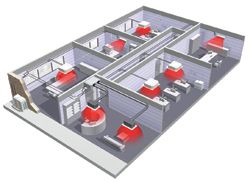Today's super-efficient heat pumps with inverter control and variable refrigerant flow offer all kinds of new possibilities. John Durbin looks at some of the latest innovations and their applications within the commercial market.
The history of heat pumps is a tale of continual innovation. Daikin brought its first heat pump air conditioner to the market way back in 1951. By 1982, it had developed its VRV (Variable Refrigerant Volume) system; this and variant refrigerant flow models from other manufacturers collectively transformed the air conditioning market. Since then, the drive for ever greater efficiencies has been relentless. The latest advances in inverter control and integrated heat recovery systems are now capable of delivering previously unimaginable efficiencies of 9 or even 10.
Heat transfer technology
The principle of heat pump technology is simple - although their multitude of applications in today's commercial environment are anything but. Heat pumps simply transfer heat from one environment to another via refrigerant. In cooling mode, they transfer the heat from an enclosed area to the outside air, thus cooling the area in question. When this process is reversed, heat pumps can extract heat from the outside air and transfer it indoors, allowing indoor environments to be heated using the same technology.

Today, heat pumps are an integral part of many air conditioning, heating, ventilation and refrigeration systems and are used in all kinds of domestic and commercial applications - from affordable housing, heritage homes and modern apartment buildings, to offices, hotels, hospitals and retail environments. Higher capacity heat pump systems are capable of meeting exacting industrial heating and cooling requirements. However, for truly impressive performance in a heat pump, inverter technology is key.
Inverters adjust the power used to suit the actual requirement. An inverter unit will gradually increase its capacity based on the capacity needed in the room to cool down or heat up the room. While a non-inverter heat pump can be compared with switching a lamp on or off, inverter technology is more like an accelerator in a car - the harder you push, the faster you go.
This provides two clear benefits. An inverter improves comfort levels for building users. Unlike standard on/off systems, an air conditioning system with an inverter continuously adjusts its cooling and heating output to suit the temperature in the room. The inverter shortens system start-up time, so that the required room temperature is reached more quickly and temperature fluctuations are avoided. Then as soon as that temperature is reached, the inverter ensures that it is constantly maintained. Secondly, because an inverter continually monitors and adjusts ambient temperature whenever needed, it avoids cycling of the compressor meaning that there are no voltage peaks and energy consumption is therefore up to 30 per cent lower than a traditional on/off system.

Manufacturers have continued to hone inverter technologies over the years, from inverters designed to maximise comfort in commercial environments to the latest super inverter models. Last year, another new innovation in inverter technology was introduced to comply with forthcoming energy-related products legislation, which will require air conditioning equipment to demonstrate seasonal efficiency ratings rather than the nominal performance ratings previously used.
The Sky Air Seasonal Inverter RZQ is the first optimised for seasonal efficiency all year round. It offers major improvements over contemporary non inverter systems.
Lasy year also saw the launch of solutions to upgrade existing heat pump systems originally installed using R22 refrigerant. With virgin-R22 refrigerant now banned and all R-22 refrigerant to be phased out by 2015, the replacement of R22 systems is now becoming a priority for contractors and end users alike. But as well as being an unavoidable necessity, replacing R-22 systems offers real opportunities to improve the performance of existing systems too.
Systems such as the Daikin VRVIII-Q run on R410A refrigerant, which is non-ozone depleting, so the environmental advantages of replacing R-22 systems are obvious.
What many building users may not yet realise, however, is that these replacement systems can be used with existing pipework and possibly existing fan coils, so there are major cost advantages over ripping out the whole system and starting again. The great benefit of this solution is that it can be achieved without compromising high efficiency levels, as the R410A upgrade is some 40 per cent more energy efficient than that of the R22 equivalent it is replacing.
Whatever the application of heat pumps - whether a fully integrated heat recovery building system for heating, cooling, ventilation and refrigeration, or a compact refrigeration condensing unit with a small footprint - the latest advances in inverter control, non-ozone depleting refrigerants and seasonal efficiencies will continue to deliver ever higher energy efficiencies to reduce the environmental impact of air conditioning systems.
With their continuing emphasis on enhancing energy efficiency, heat pump-based systems can only continue to grow in popularity.